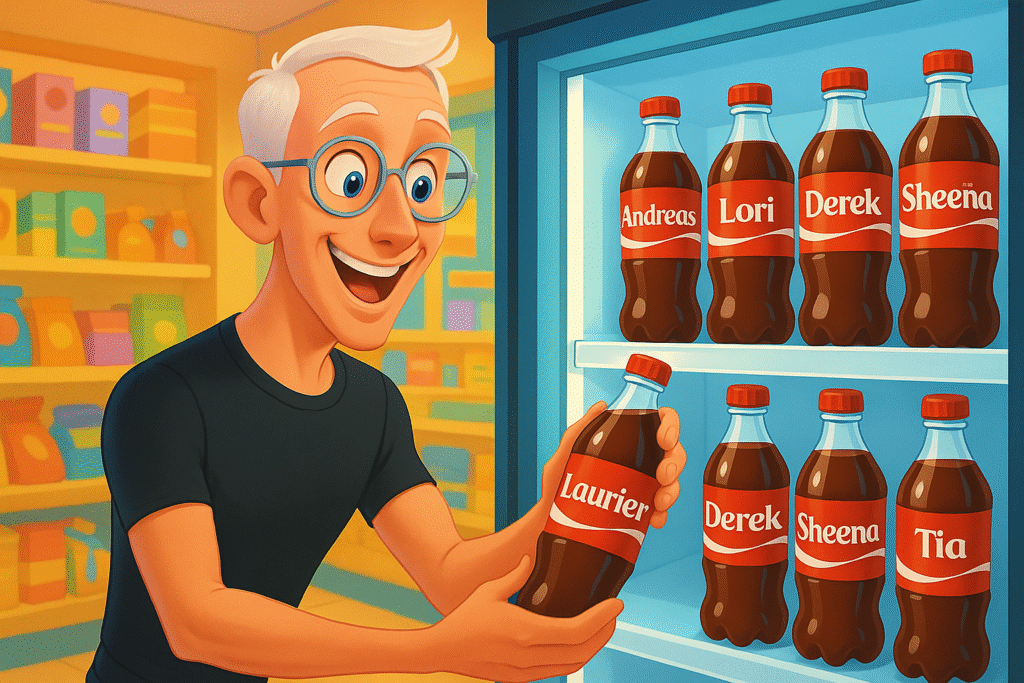
Walking through my grocery store a couple days ago, I found myself contemplating the Coca-Cola display.
Bottles labeled with names like Jillian, Brian, Summer, and Ahmed lined the cooler shelves. Plenty of unusual ones, yet I already knew I wouldn’t find mine.
It took me straight back to childhood — standing in a souvenir shop, scanning the turnstiles of keytags for my name. Finally, my mother broke the news that would shape my relationship with personalized merchandise to this day:
“It’s never going to happen.”
Some names just don’t make the cut.
The “Share a Coke” campaign is a deceptively simple concept: replace the iconic Coca-Cola logo with popular first names, nicknames, or phrases like “BFF” or “Soulmate.”
But this is bigger than finding your own name on a bottle (though that’s certainly part of the appeal). It aims to encourage consumers to find bottles with names of friends, family, or loved ones — to buy them, share them, and create emotional connections through a carbonated social currency.
In most markets, Coca-Cola uses between 150 and 1,000 names, carefully selected to represent their target demographics. The company knows perfectly well that many names won’t make the list.
That’s a feature, not a bug.
In I Need That, I explain how scarcity and exclusivity can paradoxically increase desire. By keeping certain names hard to find, Coca-Cola creates a treasure hunt mentality. The joy of finally spotting your friend’s unusual name becomes that much more satisfying.
If I found my friend Andreas’ name, I’d probably buy it. (Even knowing full well he’s a Dr. Pepper fan.)
For those of us with really uncommon names, Coca-Cola offers digital customization via QR codes or websites like ShareaCoke.com.
I tried to order one with my name on it: it’s still “in review” — to ensure it doesn’t mean something offensive, presumably. Fair enough, when one of the world’s most valuable brands is at stake!

Some markets even feature in-person kiosks for personalized bottles.
But these options are secondary. The real magic (thing) happens in the spontaneous discovery, not the planned personalization.
This campaign taps into personalization as a trend, but its real genius is in social engagement. The hashtag #ShareaCoke amplifies the experience, transforming private moments into public displays of connection.
Every shared bottle becomes content, every gift a potential viral moment.
The results speak volumes: a 2% sales increase in the U.S. market (massive for a mature and already ubiquitous product), increased relevance among younger audiences, and a marketing case study that’s still discussed over a decade later.
Product Payoff: A similar psychology was applied by Lego with its “Build Together” campaign, which didn’t try to appeal to every possible builder. Instead, Lego created specialized sets targeting specific groups (architecture fans, Star Wars enthusiasts, adult builders) while maintaining broad themes of creativity and connection.
Action for today: Consider how your product might benefit from strategic incompleteness. What deliberate limitations might create more engagement rather than less?
Is there a way to transform your product into a social object that people want to share, gift, or discuss — or will pay a premium to customize, like my $9 bottle o’ Coke? Sometimes the most powerful connections come not from universal availability but from the joy of discovery and the meaning of sharing.
Have you had your own “no representation on a keytag” moments with brands? Or created campaigns that leveraged personalization?
Tap that reply arrow and share your experiences with the power of seeing (or not seeing) yourself in a product.
I ALWAYS write back.
Or reach out to my amazing team of product branding strategists at Graphos Product.
